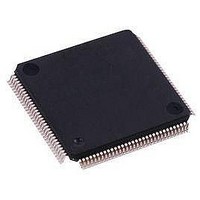AT91SAM7SE256B-AUR Atmel, AT91SAM7SE256B-AUR Datasheet - Page 404

AT91SAM7SE256B-AUR
Manufacturer Part Number
AT91SAM7SE256B-AUR
Description
IC ARM7 MCU FLASH 256K 128-LQFP
Manufacturer
Atmel
Series
AT91SAMr
Datasheet
1.AT91SAM7SE256-AU.pdf
(673 pages)
Specifications of AT91SAM7SE256B-AUR
Core Processor
ARM7
Core Size
16/32-Bit
Speed
55MHz
Connectivity
EBI/EMI, I²C, SPI, SSC, UART/USART, USB
Peripherals
Brown-out Detect/Reset, POR, PWM, WDT
Number Of I /o
88
Program Memory Size
256KB (256K x 8)
Program Memory Type
FLASH
Ram Size
32K x 8
Voltage - Supply (vcc/vdd)
1.65 V ~ 1.95 V
Data Converters
A/D 8x10b
Oscillator Type
Internal
Operating Temperature
-40°C ~ 85°C
Package / Case
*
Processor Series
SAM7SE256
Core
ARM7TDMI
Data Bus Width
32 bit
Data Ram Size
32 KB
Interface Type
SPI, USB
Maximum Clock Frequency
48 MHz
Number Of Programmable I/os
88
Maximum Operating Temperature
+ 85 C
Mounting Style
SMD/SMT
Operating Temperature Range
- 40 C to + 85 C
Processor To Be Evaluated
AT91SAM7SE256B
Supply Current (max)
60 uA
Lead Free Status / RoHS Status
Lead free / RoHS Compliant
Eeprom Size
-
Lead Free Status / Rohs Status
Details
Available stocks
Company
Part Number
Manufacturer
Quantity
Price
- Current page: 404 of 673
- Download datasheet (11Mb)
Figure 33-13. Timeguard Operations
33.6.3.8
404
Baud Rate
TXEMPTY
US_THR
TXRDY
Clock
Write
TXD
SAM7SE512/256/32 Preliminary
Receiver Time-out
Start
Bit
D0
D1
Table 33-7
in relation to the function of the Baud Rate.
Table 33-7.
The Receiver Time-out provides support in handling variable-length frames. This feature detects
an idle condition on the RXD line. When a time-out is detected, the bit TIMEOUT in the Channel
Status Register (US_CSR) rises and can generate an interrupt, thus indicating to the driver an
end of frame.
The time-out delay period (during which the receiver waits for a new character) is programmed
in the TO field of the Receiver Time-out Register (US_RTOR). If the TO field is programmed at
0, the Receiver Time-out is disabled and no time-out is detected. The TIMEOUT bit in US_CSR
remains at 0. Otherwise, the receiver loads a 16-bit counter with the value programmed in TO.
This counter is decremented at each bit period and reloaded each time a new character is
received. If the counter reaches 0, the TIMEOUT bit in the Status Register rises. Then, the user
can either:
D2
• Stop the counter clock until a new character is received. This is performed by writing the
Control Register (US_CR) with the STTTO (Start Time-out) bit at 1. In this case, the idle state
D3
D4
D5
Baud Rate
indicates the maximum length of a timeguard period that the transmitter can handle
115200
Bit/sec
14400
19200
28800
33400
56000
57600
1 200
9 600
D6
Maximum Timeguard Length Depending on Baud Rate
D7
Parity
Bit
Stop
Bit
TG = 4
Start
Bit
D0
Bit time
69.4
52.1
34.7
29.9
17.9
17.4
D1
833
104
8.7
µs
D2
D3
D4
D5
D6
D7
Parity
Bit
Stop
Bit
Timeguard
6222F–ATARM–14-Jan-11
212.50
26.56
17.71
13.28
8.85
7.63
4.55
4.43
2.21
TG = 4
ms
Related parts for AT91SAM7SE256B-AUR
Image
Part Number
Description
Manufacturer
Datasheet
Request
R

Part Number:
Description:
EVAL BOARD FOR AT91SAM7SE
Manufacturer:
Atmel
Datasheet:

Part Number:
Description:
DEV KIT FOR AVR/AVR32
Manufacturer:
Atmel
Datasheet:

Part Number:
Description:
INTERVAL AND WIPE/WASH WIPER CONTROL IC WITH DELAY
Manufacturer:
ATMEL Corporation
Datasheet:

Part Number:
Description:
Low-Voltage Voice-Switched IC for Hands-Free Operation
Manufacturer:
ATMEL Corporation
Datasheet:

Part Number:
Description:
MONOLITHIC INTEGRATED FEATUREPHONE CIRCUIT
Manufacturer:
ATMEL Corporation
Datasheet:

Part Number:
Description:
AM-FM Receiver IC U4255BM-M
Manufacturer:
ATMEL Corporation
Datasheet:

Part Number:
Description:
Monolithic Integrated Feature Phone Circuit
Manufacturer:
ATMEL Corporation
Datasheet:

Part Number:
Description:
Multistandard Video-IF and Quasi Parallel Sound Processing
Manufacturer:
ATMEL Corporation
Datasheet:

Part Number:
Description:
High-performance EE PLD
Manufacturer:
ATMEL Corporation
Datasheet:

Part Number:
Description:
8-bit Flash Microcontroller
Manufacturer:
ATMEL Corporation
Datasheet:

Part Number:
Description:
2-Wire Serial EEPROM
Manufacturer:
ATMEL Corporation
Datasheet:











